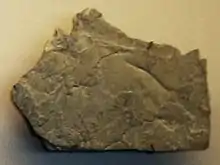Marpolia
Marpolia has been interpreted as a cyanobacterium, but also resembles the modern cladophoran green algae. It is known from the Middle Cambrian Burgess shale[1] and Early Cambrian deposits from the Czech Republic.[2] It comprises a dense mass of entangled, twisted filaments. It may have been free-floating or grown on other objects, although there is no evidence of attachment structures.[1] 40 specimens of Marpolia are known from the Greater Phyllopod bed, where they comprise 0.08% of the community.[3]
| Marpolia | |
|---|---|
 | |
| Marpolia spissa | |
| Scientific classification | |
| Kingdom: | |
| Phylum: | |
| Genus: | Marpolia |
| Species: | M. spissa Walcott 1919 |
References
- Briggs, D.E.G.; Erwin, D.H.; Collier, F.J. (1995), Fossils of the Burgess Shale, Washington: Smithsonian Inst Press, ISBN 1-56098-659-X, OCLC 231793738
- "Steiner, M., Fatka, O., 1996, Lower Cambrian tubular micro- to macrofossils from the Paseky Shale of the Barrandian area (Czech Republic): Paläontologische Zeitschrift, v, 70, p. 275–299" (PDF). Archived from the original (PDF) on 2012-03-26. Cite journal requires
|journal=(help) - Caron, Jean-Bernard; Jackson, Donald A. (October 2006). "Taphonomy of the Greater Phyllopod Bed community, Burgess Shale". PALAIOS. 21 (5): 451–65. doi:10.2110/palo.2003.P05-070R. JSTOR 20173022.
This article is issued from Wikipedia. The text is licensed under Creative Commons - Attribution - Sharealike. Additional terms may apply for the media files.